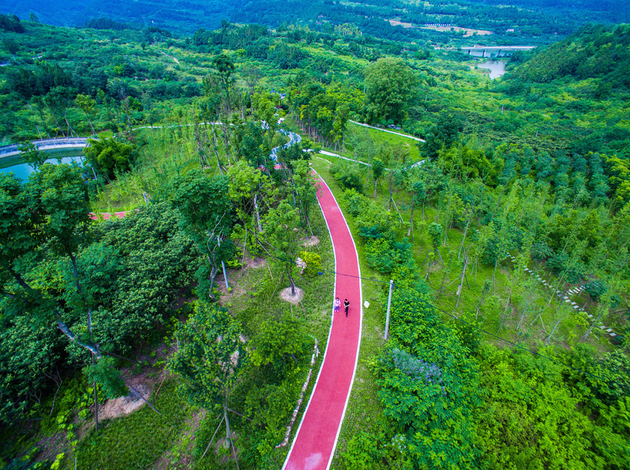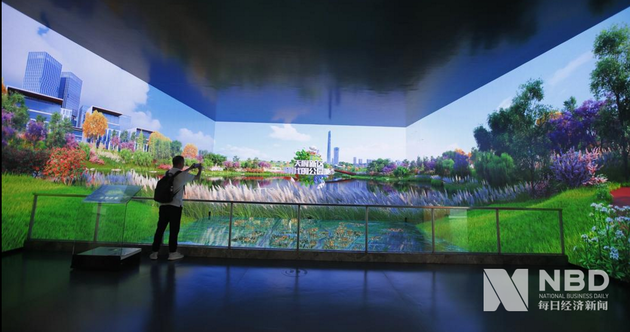
Photo/VCG
Apr. 23(NBD) – On Monday, 300 guests at home and abroad including government officials, representatives of UN-Habitat, leaders of global park cities and city-planning experts gathered at the first Park City Forum in Chengdu, sharing their insights on building beautiful and livable park cities.
"I think the challenge in the future is not to take a horticulture stand but think in a more ecological way when constructing urban forest," underlined James Hitchmough, the lead planting design and horticultural consultant at the 2012 Olympic Park, in an interview with NBD.
Being a park city is not enough but a global park city is which is expected to establish international green attractions.
"Our greening projects are not only designed to build a livable city for residents, but also to attract foreign investment," Chuah Hock Seong, the group director of National Parks Board, Singapore, told NBD.
Global park cities should display sustainability
"It only takes a government 2 or 3 years to build a park with a sum of money," Chuah told NBD in an exclusive interview. "However, each plant is a living thing needed to be cared."
Park cities do not merely mean building parks where trees are planted in cities. Maintenance plays an integral part of Singapore’s success. Besides this, the authorities should be poised to constantly improving their approaches, Chuah added.
Singapore's Garden City journey began in 1963, when then Prime Minister Lee Kuan Yew planted a Mempat tree signifying the start of the greening campaign. Through the dedication and commitment of its pioneers and the community, the landscape has transformed to one where Greenery is a major feature.
From 1960 to 1980, Singapore aimed to build itself into a park city while in 1990, the government proposed the new desire to be "a city in the garden" in order to make life more pleasant for the people as well as draw increased numbers of tourists and foreign investment.
Singapore's journey towards "city in a garden" never ceases evolving and turned Singapore into a biophilic "City in a Garden" five years ago.
"We never stop to optimize our philosophy. It was in the 1960s when the government was determined to greening Singapore. Now National Parks Board has about 1400 employees while at the beginning, there were only 20 or 30 workers," Chuah said to NBD, "To fulfill the vision, the funds are fully invested by the government that sees greening Singapore as a must-do for its people."

Photo/Zhang Jian (NBD)
Global park cities should establish world-class green attractions
Jewel Changi Airport, the integration of nature with engineering marvels housed under a striking glass and steel dome, becomes a new popular destination for overseas tourists in Singapore, like Singapore Botanic Gardens and Gardens By the Bay.
"Singapore Botanic Gardens was inscribed as a World Heritage Site by the UNESCO World Heritage Committee and only three botanic gardens in the world were awarded the coveted status," Chuah said in the interview, "Garden By the Bay was completed in 2012 while it has become ten must-see attractions across the globe attracting more than 10 million visitors last year."
Besides Singapore, Royal Botanic Gardens and Hyde Park are also attractive to numerous tourists as a must see in London. And in Chengdu, Chengdu Research Base of Giant Panda and Tianfu Greenway are increasingly building up its influence among global park cities.
How to establish a world-class green attraction integrating local species with international narrative?
"I think everyone's thinking about vegetation may stay green but we actually have many approaches to dealing with it," underlined Hitchmough at the forum. This English scholar finds planting and greening ubiquitous throughout China, while he argues that it is hard to distinguish between two regions even with different geographical characteristics in this country.
"How to make Chengdu stand out? We can consider designing different landscapes in this city where different types of vegetation are planted. In no way shall we agree or accept that any two of them should be the same," Hitchmough said.
When leading planting in the London 2012 Olympic Park project, Hitchmough and his colleague enriched the park with colours from around the globe such as orange poppies from California, ruby-red gladiolus from South Africa. "If you only have access to a smaller range of species, it (the park) can't keep looking good for so long," Hitchmough told NBD, "I am opposed to doing the same on every site. I do not think it works."
There witnesses the similar attitude in Singapore. "We are open to vegetation selection including not only native species but also alien ones. Our only criterion is high aesthetic value but low maintenance costs," concluded Chuah.
Email: gaohan@nbd.com.cn


 川公网安备 51019002001991号
川公网安备 51019002001991号





